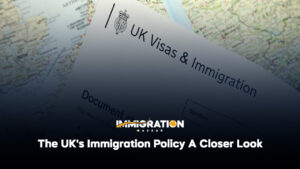In recent years, U.S. immigration policies have seen significant fluctuations, particularly regarding individuals entering the country illegally. This has raised concerns for many, especially those considering travel to the U.S., whether for study or other purposes. Understanding these dynamics is essential for anyone planning to navigate the complexities of U.S. immigration, particularly if they are considering using a second passport.
-
Current State of U.S. Immigration
1.1 Recent Trends in Illegal Entry
As reported, there has been a notable uptick in individuals attempting to enter the U.S. illegally. While the current administration has not imposed strict measures against those entering without proper documentation, this may change with future political shifts. Such uncertainty creates a complicated environment for legitimate travelers and students.
1.2 The Role of a Second Passport
For individuals holding dual citizenship or a second passport, the implications of traveling on a second passport can vary significantly. A second passport can be a useful tool, particularly for those who might face issues with their primary passport due to travel restrictions or visa challenges.
-
Why Consider a Second Passport?
2.1 Benefits of a Second Passport
- Enhanced Travel Flexibility: A second passport can provide access to countries that may have restrictions on the primary passport.
- Visa-Free Travel: Some passports offer broader visa-free access, making international travel smoother.
- Backup Option: In case of loss or theft of a primary passport, a second passport serves as a backup, allowing continued travel.
2.2 Risks and Considerations
- Legal Implications: Travelers must be aware of the legal stipulations surrounding dual citizenship, especially in relation to entry into the U.S. with a second passport.
- Increased Scrutiny: Using a second passport may lead to increased scrutiny at immigration checkpoints, particularly if there are discrepancies in travel histories.
-
U.S. Visa Process for Students and Travelers
3.1 Understanding Visa Types
For students planning to study in the U.S., understanding the various visa categories is crucial:
- F-1 Visa: For academic students attending a college or university.
- J-1 Visa: For exchange visitors, including those in specific programs or internships.
- M-1 Visa: For vocational or non-academic programs.
Each visa type has specific requirements and processes, which can be affected by current immigration policies.
3.2 Application Process
The application process typically involves several steps:
- Receiving an I-20 Form: Issued by the U.S. institution, confirming acceptance into a program.
- Paying the SEVIS Fee: This fee supports the Student and Exchange Visitor Information System.
- Completing the Visa Application (Form DS-160): Necessary for scheduling a visa interview.
- Visa Interview: Conducted at a U.S. embassy or consulate, where applicants must demonstrate their intent to study and return home after their studies.
-
Impacts of Immigration Policies on International Students
4.1 Stricter Immigration Controls
As U.S. immigration policies become more stringent, international students may face additional challenges:
- Increased Documentation Requirements: Students may need to provide more evidence of financial stability, ties to their home country, and intent to return.
- Longer Processing Times: The visa application process may take longer, impacting students’ timelines for starting their programs.
4.2 Navigating Changes in Policy
Students must stay informed about changes in immigration policies that could affect their ability to study in the U.S. Keeping track of government announcements and maintaining close communication with educational institutions can help mitigate potential issues.
-
Preparing for Travel to the U.S.
5.1 Research and Planning
For anyone considering travel to the U.S. on a second passport, thorough research and preparation are essential:
- Understand Entry Requirements: Familiarize yourself with current entry regulations and visa policies that may apply to your nationality and circumstances.
- Consult with Experts: Immigration attorneys or experts can provide tailored advice based on individual situations.
5.2 Document Organization
- Maintain Updated Documents: Ensure both passports (if applicable) are valid and up to date. Keep copies of important documents, including visa applications and acceptance letters from educational institutions.
- Financial Documentation: Prepare to demonstrate financial stability through bank statements or sponsorship letters.
-
Conclusion: The Road Ahead for Travelers and Students
As the landscape of U.S. immigration continues to evolve, it’s crucial for travelers and students to stay informed and proactive. For those considering using a second passport, understanding the implications and benefits can aid in navigating the complexities of entry into the U.S. With careful planning, thorough research, and awareness of current trends, aspiring travelers can better position themselves for successful journeys and educational experiences in the United States.
Final Thoughts
Traveling to the U.S., particularly as a student, involves navigating a complex web of immigration policies and regulations. As current situations unfold, staying informed about visa requirements, understanding the implications of traveling with a second passport, and being prepared for potential changes in immigration policy are essential steps for success. Whether for education or other purposes, the journey can be significantly smoother with the right information and preparation.







